Using Blofeld as a Drum Sampler: Part 2
Last time I tried to use the Blofeld as essentially a drum trigger/sampler by chopping up the Amen break and placing different parts of it on different keys, which could then be triggered as one-shots by choosing it as the source of an oscillator. This time, I wanted to go further, by taking multiple kick and snare samples and placing them along the keyboard, mapping the root note and highest note to the same value, and then triggering them by playing the appropriate notes. Now that I’ve switched to windows to run Spectre, this should be a breeze, so here’s what I did:
- I loaded two octaves’ worth of kick and snare samples in two different
 programs. At first I loaded the samples starting on the lowest note, but that didn’t work, so I started on C3 or C4, mapping a different sample to each note for two octaves. I repeated this process on a new program for snares as well.
programs. At first I loaded the samples starting on the lowest note, but that didn’t work, so I started on C3 or C4, mapping a different sample to each note for two octaves. I repeated this process on a new program for snares as well. - My next step was to create an init patch where oscillator 1 was set to the kick sample program and oscillator 2 was set to the snare program, with both levels turned down. This can be the starting point for both kicks and snares simply by turning up the level on oscillator 1 or 2.
- Then I took this init patch and created an arpeggiator with no user pattern, an arp note value of 1/16 and note length of at least 1/8 to 1/4 (1/2 overlaps other notes and shorter than 1/8 cuts off the release), which creates a 4/4 kick pattern.
- Then in the multi, I selected this patch and used the transpose setting to choose which sample played. I noticed that the transpose setting goes high enough in both directions to map a different sample to every note, if desired. I did the same thing for the snare sample and arpeggiator like for the kick in step 3, only I set up a user pattern so it would trigger on just the 2s and 4s. I don’t think fixed pitch does anything when you’re mapping the samples to single notes, and so the snare program was not set up with fixed pitch, but I should double-check that the sample is triggering at the same pitch as the original sample.
- I set up the one-shot trigger for a reverse snare using a sample from the snare program. With no arp enabled, this can be triggered whenever you want, again by using the transpose setting in multi mode to choose which note is played. That way before the end of a measure I can trigger a simple build.
- If you want to change the sample’s amplitude settings, you can shorten the sample using the VCA decay or attack, but you don’t have that much control over note length unless you map a single value across the keyboard range. That of course will change the pitch of the sample considerably as well. I also found that if you change the semitone setting the sample changes completely to whatever is mapped to that note, it doesn’t tune the sample. But, you can tune the sample up maybe a semitone by using the detune knob; past 0 in the positive direction tunes the sample up. Interestingly, past 0 in the negative direction changes to the next lower note’s sample, which prevents you from tuning it down at all. It’s nice to know that there is at least some possibility of editing the note’s properties, and of course, the filters are fully available to shape the sample’s tone.
Conclusion
I now have 8 sound programs assigned: 3 one-shot samples for fills (snare, clap, and reverse snare), 3 drum arps (kick, snare, and hihat), 1 bass arp, and a polyphonic keyboard mapped to the top of the keyboard. Usually I am only playing 5-6 simultaneously, all triggered live from a keyboard, and it didn’t seem to choke or crash very much if it all so in performance-only mode it was pretty stable. I don’t recall it ever dropping voices, although I’m essentially using only mono patches and single voices other than the keys patch. Maybe there was the occasional arp glitch, but I’m not sure that wasn’t due to human error. I did have some issues when triggering many patches at once while simultaneously changing the transpose setting; the synth hung a few times, emitting a loud squeal. It also occasionally wanted to latch the arp when transposing and I had to push shift-play to break out of it. I really don’t think I’m using this synthesizer in the way they might have intended and I assume that is why it’s a little glitchy, but overall, despite the glitches, I’m pretty pleased with how versatile the Blofeld is showing itself to be in the sampling department.